Yezi Liu
LVLM_CSP: Accelerating Large Vision Language Models via Clustering, Scattering, and Pruning for Reasoning Segmentation
Apr 15, 2025Abstract:Large Vision Language Models (LVLMs) have been widely adopted to guide vision foundation models in performing reasoning segmentation tasks, achieving impressive performance. However, the substantial computational overhead associated with LVLMs presents a new challenge. The primary source of this computational cost arises from processing hundreds of image tokens. Therefore, an effective strategy to mitigate such overhead is to reduce the number of image tokens, a process known as image token pruning. Previous studies on image token pruning for LVLMs have primarily focused on high level visual understanding tasks, such as visual question answering and image captioning. In contrast, guiding vision foundation models to generate accurate visual masks based on textual queries demands precise semantic and spatial reasoning capabilities. Consequently, pruning methods must carefully control individual image tokens throughout the LVLM reasoning process. Our empirical analysis reveals that existing methods struggle to adequately balance reductions in computational overhead with the necessity to maintain high segmentation accuracy. In this work, we propose LVLM_CSP, a novel training free visual token pruning method specifically designed for LVLM based reasoning segmentation tasks. LVLM_CSP consists of three stages: clustering, scattering, and pruning. Initially, the LVLM performs coarse-grained visual reasoning using a subset of selected image tokens. Next, fine grained reasoning is conducted, and finally, most visual tokens are pruned in the last stage. Extensive experiments demonstrate that LVLM_CSP achieves a 65% reduction in image token inference FLOPs with virtually no accuracy degradation, and a 70% reduction with only a minor 1% drop in accuracy on the 7B LVLM.
Tell Me What to Track: Infusing Robust Language Guidance for Enhanced Referring Multi-Object Tracking
Dec 17, 2024Abstract:Referring multi-object tracking (RMOT) is an emerging cross-modal task that aims to localize an arbitrary number of targets based on a language expression and continuously track them in a video. This intricate task involves reasoning on multi-modal data and precise target localization with temporal association. However, prior studies overlook the imbalanced data distribution between newborn targets and existing targets due to the nature of the task. In addition, they only indirectly fuse multi-modal features, struggling to deliver clear guidance on newborn target detection. To solve the above issues, we conduct a collaborative matching strategy to alleviate the impact of the imbalance, boosting the ability to detect newborn targets while maintaining tracking performance. In the encoder, we integrate and enhance the cross-modal and multi-scale fusion, overcoming the bottlenecks in previous work, where limited multi-modal information is shared and interacted between feature maps. In the decoder, we also develop a referring-infused adaptation that provides explicit referring guidance through the query tokens. The experiments showcase the superior performance of our model (+3.42%) compared to prior works, demonstrating the effectiveness of our designs.
Gradient Inversion Attack on Graph Neural Networks
Nov 29, 2024



Abstract:Graph federated learning is of essential importance for training over large graph datasets while protecting data privacy, where each client stores a subset of local graph data, while the server collects the local gradients and broadcasts only the aggregated gradients. Recent studies reveal that a malicious attacker can steal private image data from gradient exchanging of neural networks during federated learning. However, none of the existing works have studied the vulnerability of graph data and graph neural networks under such attack. To answer this question, the present paper studies the problem of whether private data can be recovered from leaked gradients in both node classification and graph classification tasks and { proposes a novel attack named Graph Leakage from Gradients (GLG)}. Two widely-used GNN frameworks are analyzed, namely GCN and GraphSAGE. The effects of different model settings on recovery are extensively discussed. Through theoretical analysis and empirical validation, it is shown that parts of the graph data can be leaked from the gradients.
VLTP: Vision-Language Guided Token Pruning for Task-Oriented Segmentation
Sep 13, 2024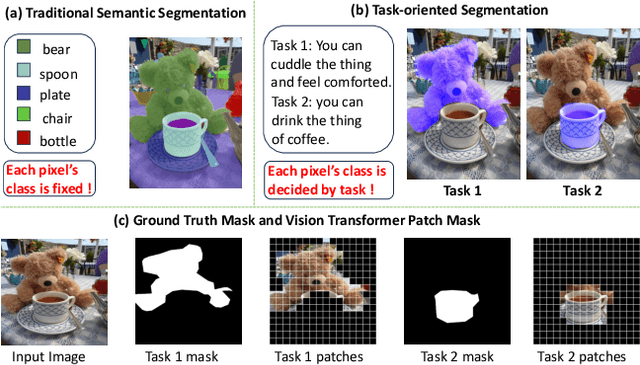
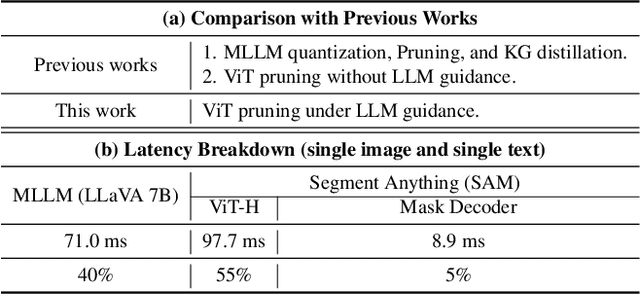
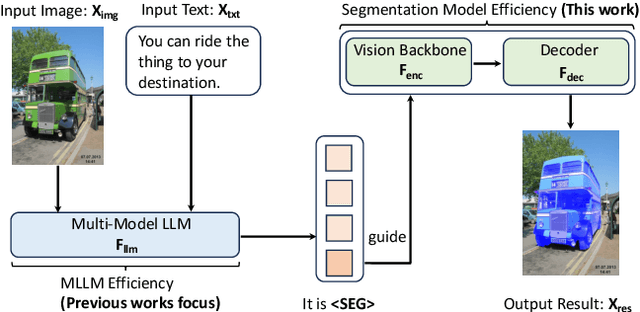
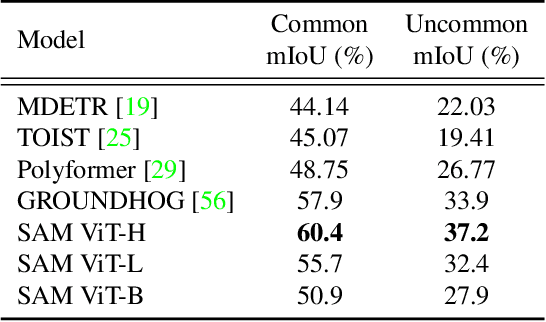
Abstract:Vision Transformers (ViTs) have emerged as the backbone of many segmentation models, consistently achieving state-of-the-art (SOTA) performance. However, their success comes at a significant computational cost. Image token pruning is one of the most effective strategies to address this complexity. However, previous approaches fall short when applied to more complex task-oriented segmentation (TOS), where the class of each image patch is not predefined but dependent on the specific input task. This work introduces the Vision Language Guided Token Pruning (VLTP), a novel token pruning mechanism that can accelerate ViTbased segmentation models, particularly for TOS guided by multi-modal large language model (MLLM). We argue that ViT does not need to process every image token through all of its layers only the tokens related to reasoning tasks are necessary. We design a new pruning decoder to take both image tokens and vision-language guidance as input to predict the relevance of each image token to the task. Only image tokens with high relevance are passed to deeper layers of the ViT. Experiments show that the VLTP framework reduces the computational costs of ViT by approximately 25% without performance degradation and by around 40% with only a 1% performance drop.
Promoting Fairness in Link Prediction with Graph Enhancement
Sep 13, 2024Abstract:Link prediction is a crucial task in network analysis, but it has been shown to be prone to biased predictions, particularly when links are unfairly predicted between nodes from different sensitive groups. In this paper, we study the fair link prediction problem, which aims to ensure that the predicted link probability is independent of the sensitive attributes of the connected nodes. Existing methods typically incorporate debiasing techniques within graph embeddings to mitigate this issue. However, training on large real-world graphs is already challenging, and adding fairness constraints can further complicate the process. To overcome this challenge, we propose FairLink, a method that learns a fairness-enhanced graph to bypass the need for debiasing during the link predictor's training. FairLink maintains link prediction accuracy by ensuring that the enhanced graph follows a training trajectory similar to that of the original input graph. Meanwhile, it enhances fairness by minimizing the absolute difference in link probabilities between node pairs within the same sensitive group and those between node pairs from different sensitive groups. Our extensive experiments on multiple large-scale graphs demonstrate that FairLink not only promotes fairness but also often achieves link prediction accuracy comparable to baseline methods. Most importantly, the enhanced graph exhibits strong generalizability across different GNN architectures.
Recoverable Anonymization for Pose Estimation: A Privacy-Enhancing Approach
Sep 01, 2024Abstract:Human pose estimation (HPE) is crucial for various applications. However, deploying HPE algorithms in surveillance contexts raises significant privacy concerns due to the potential leakage of sensitive personal information (SPI) such as facial features, and ethnicity. Existing privacy-enhancing methods often compromise either privacy or performance, or they require costly additional modalities. We propose a novel privacy-enhancing system that generates privacy-enhanced portraits while maintaining high HPE performance. Our key innovations include the reversible recovery of SPI for authorized personnel and the preservation of contextual information. By jointly optimizing a privacy-enhancing module, a privacy recovery module, and a pose estimator, our system ensures robust privacy protection, efficient SPI recovery, and high-performance HPE. Experimental results demonstrate the system's robust performance in privacy enhancement, SPI recovery, and HPE.
TinyGraph: Joint Feature and Node Condensation for Graph Neural Networks
Jul 10, 2024Abstract:Training graph neural networks (GNNs) on large-scale graphs can be challenging due to the high computational expense caused by the massive number of nodes and high-dimensional nodal features. Existing graph condensation studies tackle this problem only by reducing the number of nodes in the graph. However, the resulting condensed graph data can still be cumbersome. Specifically, although the nodes of the Citeseer dataset are reduced to 0.9% (30 nodes) in training, the number of features is 3,703, severely exceeding the training sample magnitude. Faced with this challenge, we study the problem of joint condensation for both features and nodes in large-scale graphs. This task is challenging mainly due to 1) the intertwined nature of the node features and the graph structure calls for the feature condensation solver to be structure-aware; and 2) the difficulty of keeping useful information in the condensed graph. To address these challenges, we propose a novel framework TinyGraph, to condense features and nodes simultaneously in graphs. Specifically, we cast the problem as matching the gradients of GNN weights trained on the condensed graph and the gradients obtained from training over the original graph, where the feature condensation is achieved by a trainable function. The condensed graph obtained by minimizing the matching loss along the training trajectory can henceforth retain critical information in the original graph. Extensive experiments were carried out to demonstrate the effectiveness of the proposed TinyGraph. For example, a GNN trained with TinyGraph retains 98.5% and 97.5% of the original test accuracy on the Cora and Citeseer datasets, respectively, while significantly reducing the number of nodes by 97.4% and 98.2%, and the number of features by 90.0% on both datasets.
Contrastive Knowledge Graph Error Detection
Nov 18, 2022Abstract:Knowledge Graph (KG) errors introduce non-negligible noise, severely affecting KG-related downstream tasks. Detecting errors in KGs is challenging since the patterns of errors are unknown and diverse, while ground-truth labels are rare or even unavailable. A traditional solution is to construct logical rules to verify triples, but it is not generalizable since different KGs have distinct rules with domain knowledge involved. Recent studies focus on designing tailored detectors or ranking triples based on KG embedding loss. However, they all rely on negative samples for training, which are generated by randomly replacing the head or tail entity of existing triples. Such a negative sampling strategy is not enough for prototyping practical KG errors, e.g., (Bruce_Lee, place_of_birth, China), in which the three elements are often relevant, although mismatched. We desire a more effective unsupervised learning mechanism tailored for KG error detection. To this end, we propose a novel framework - ContrAstive knowledge Graph Error Detection (CAGED). It introduces contrastive learning into KG learning and provides a novel way of modeling KG. Instead of following the traditional setting, i.e., considering entities as nodes and relations as semantic edges, CAGED augments a KG into different hyper-views, by regarding each relational triple as a node. After joint training with KG embedding and contrastive learning loss, CAGED assesses the trustworthiness of each triple based on two learning signals, i.e., the consistency of triple representations across multi-views and the self-consistency within the triple. Extensive experiments on three real-world KGs show that CAGED outperforms state-of-the-art methods in KG error detection. Our codes and datasets are available at https://github.com/Qing145/CAGED.git.
Explaining Dynamic Graph Neural Networks via Relevance Back-propagation
Jul 22, 2022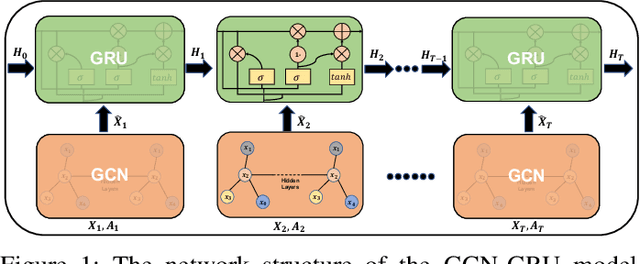
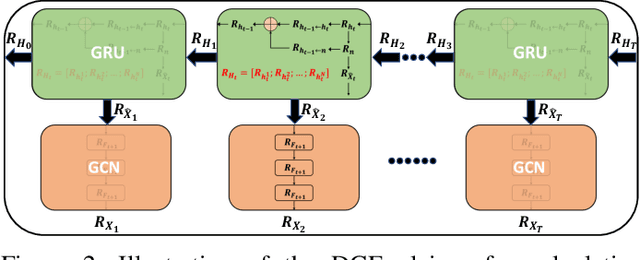
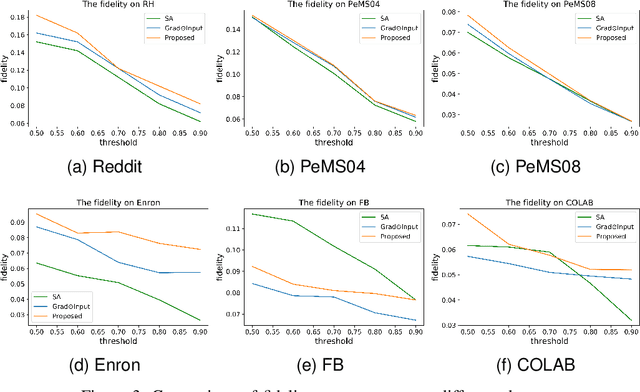
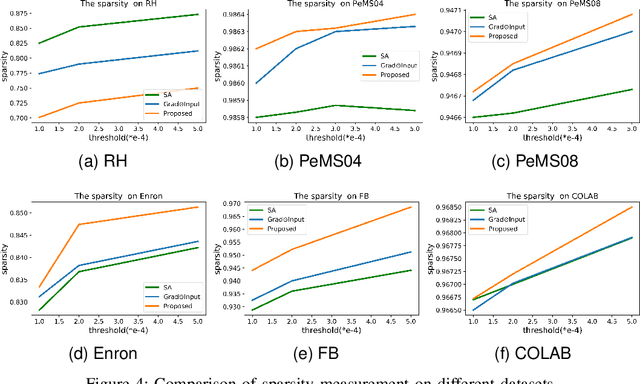
Abstract:Graph Neural Networks (GNNs) have shown remarkable effectiveness in capturing abundant information in graph-structured data. However, the black-box nature of GNNs hinders users from understanding and trusting the models, thus leading to difficulties in their applications. While recent years witness the prosperity of the studies on explaining GNNs, most of them focus on static graphs, leaving the explanation of dynamic GNNs nearly unexplored. It is challenging to explain dynamic GNNs, due to their unique characteristic of time-varying graph structures. Directly using existing models designed for static graphs on dynamic graphs is not feasible because they ignore temporal dependencies among the snapshots. In this work, we propose DGExplainer to provide reliable explanation on dynamic GNNs. DGExplainer redistributes the output activation score of a dynamic GNN to the relevances of the neurons of its previous layer, which iterates until the relevance scores of the input neuron are obtained. We conduct quantitative and qualitative experiments on real-world datasets to demonstrate the effectiveness of the proposed framework for identifying important nodes for link prediction and node regression for dynamic GNNs.
 Add to Chrome
Add to Chrome Add to Firefox
Add to Firefox Add to Edge
Add to Edge